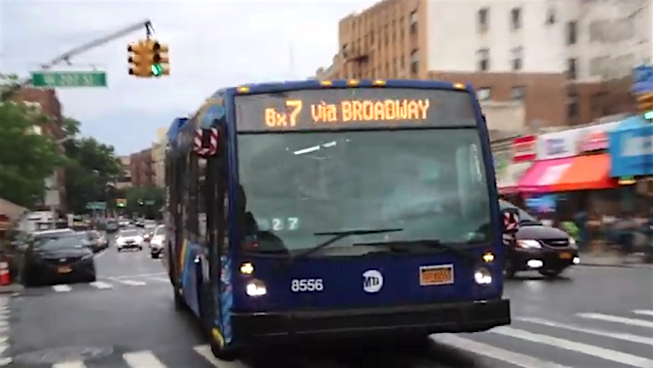‘Progressives’ Should Support Public Transit Over Private Vehicles
So why are bus lanes on Broadway so controversial for a liberal Bronx Community Board?

Some New York community boards want to stand in the way of transportation changes that would help more residents get to school and work.
Take, for example, Bronx Community Board 8, whose Traffic and Transportation Committee recently gave an “icy reception” to a Department of Transportation plan for daytime bus lanes on Broadway. Several members opposed the lanes, claiming they would create traffic jams and curtail public parking. The board snubbed DOT’s request for a quick hearing.
The reaction was dismaying, both on the substance and as a matter of public policy.
Daytime bus lanes are a cheap, easy way to improve transportation that makes sense for most local residents — and would promote key community goals such as safety and sustainability.

The stretch of Broadway in question — from 225th to 230th streets, between the Broadway Bridge and a road to the Major Deegan Expressway — is a notorious bottleneck.
Bus lanes would help calm and rationalize traffic on a badly designed road where erratic driving and double parking creates dangers for pedestrians and motorists alike. Between 2014 and 2018, 7,089 vehicle crashes occurred in CB8, with 10 fatalities — seven pedestrians and three motorists — and 1,631 injuries, according to city data.
That’s roughly four crashes per day in a relatively small neighborhood. Three of the fatalities were near Broadway.
Getting more people out of cars and onto faster buses also would improve air quality and, not incidentally, help the city achieve its ambitious climate goals: Last month, New York became the first major American city to declare a climate emergency. The stretch in question lies beneath the 1 train’s elevated tracks, trapping automobile fumes and likely worsening asthma rates among the residents of the Marble Hill Houses, the NYCHA complex straddling Broadway there.
Moreover, bus lanes would promote social equity. According to the Comptroller’s Office, lower-income communities rely on bus service more than others; a majority of bus riders are immigrants, and 75 percent come from communities of color. The average income of a bus commuter is $11,500 less than the average subway rider’s $40,000 income. These people need the MTA’s help to get to school and work.
So why do some CB8 members oppose the bus lanes?
To be sure, DOT did not do itself any favors in the way it approached the board. Apparently, DOT made its request without first communicating the project’s goals and benefits. Still, CB members are supposed to act as leaders.
Two declared 2021 City Council candidates: Dan Padernacht, the chairman, and Eric Dinowitz, serve on CB8’s Traffic and Transportation Committee. Both call themselves progressives.
“Progressives” should realize that progress means siding with the transit systems that serve the many, not with the automobiles that carry the few. Only then will we attain a safe and sustainable city. But some CB members are sowing confusion and division — without providing any evidence to back up claims that bus lanes would snarl traffic.
Bus lanes are a solution. All over the city, residents literally get stuck on their way to work and school because buses travel at an average of 8 miles an hour. A few gallons of road paint could really make a difference for working people in the outer boroughs.
“Progressives” worthy of the name should not stand in the way of that progress.
Jessica Haller is an environmentalist and community activist who lives in Riverdale. Twitter @JessicaHaller





